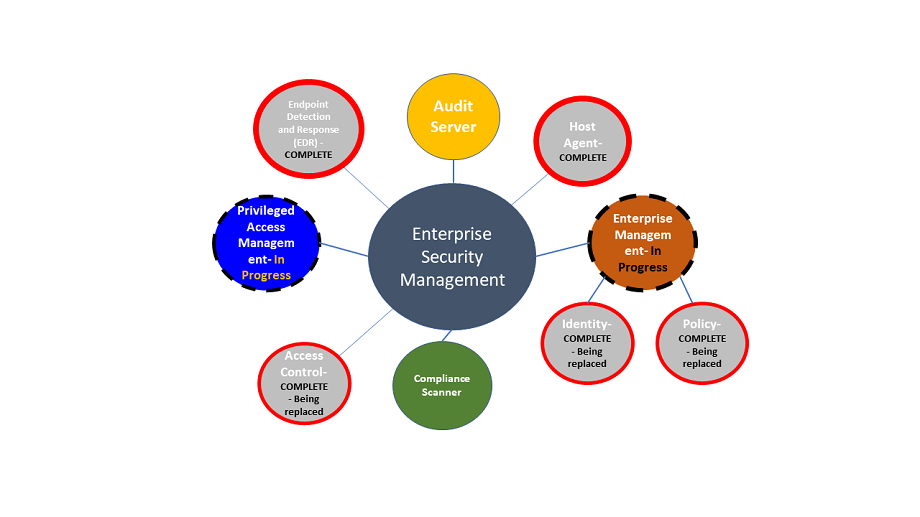 | Common Criteria Evaluation and Validation SchemeNational Information
Assurance Partnership (NIAP) |
Title: Enterprise Security Management (ESM) - Enterprise Management (EM)Maintained by: National Information Assurance Partnership (NIAP)Unique Identifier: 00xVersion: 0.2xStatus: draftDate of issue: Approved by: Supersedes: Background and Purpose
This document describes a core set of security requirements for Enterprise Security Management systems.
These requirements cover basic security characteristics and behaviors for an ESM management server.
Enterprise Security Management is a Security framework designed to control the deployment, configuration and
monitoring of security policies on host agents across multiple platforms. It is a suite of product/product components
used to provide centralized management of a set of IT assets within an organization.
The Enterprise Security Management- Enterprise Management module in the Enterprise Security Management Suite is a
centralized host system used to deploy software and manage systems across an enterprise. A service is deployed to
host agents and allow for the discovery, data capture, reporting and remediation of IT policy and security issue.
Use Cases
[USE CASE] Monitoring and Management
[USE CASE 1] Custom Events
The ability to handle custom event management and monitoring across server and workstation endpoints.
[USE CASE 2] Standard Services and Alerts
The ability to monitor multiple system services across endpoints, such as alerting for low disk space,
high memory usage alerts, account creations, accounts being added or removed from groups, services stopping.
[USE CASE 3] Patching and Policies
The ability to deploy patches, security, and business policies to server and workstation endpoints, in addition
to deploying instructions to network configurable infrastructure devices.
[USE CASE 4] Discovery
The capability to effectively browse, query, and export aggregated host-based endpoint data through a management
dashboard query interface, in addition to automatically add newly discovered endpoints to a monitored database.
[USE CASE] Expandability
[USE CASE 1] Vendor Expansion
The ability to integrate and expand with additional vendor packages for custom monitoring and configuration of varying physical and virtual hardware.
[USE CASE 2] Resource Expansion
The capability to generate performance and predictive analysis to estimate when a monitored resource will be exhausted and allow for administrators to plan accordingly.
[USE CASE] Security
The ability to function in any configuration of endpoints with or without agents in the following ways.
Agent
[USE CASE 1] Detection of Potential Unauthorized Activity
The ability for agents to detect potentially unauthorized activity, software, or users by collection of
host-based endpoint data and reporting back to the management server for further analysis.
[USE CASE 2] Remediation of Malicious Activity
The ability for the management server to instruct agents to perform remediation activities on the endpoints to cleanup detected
malicious activity and report back through secured channels.
Agentless
[USE CASE 1] Detection of Potential Unauthorized Activity
The detection of potentially unauthorized activity, software, or users is enabled by remote collection of host-based endpoint data by the management server.
[USE CASE 2] Remediation of Malicious Activity
The ability to perform remediation activities on the endpoint remotely from the management server to cleanup detected malicious activity.
Resources to be protected
- Sensitive data stored by the ESM system.
- Credentials for authentication to or from the ESM system.
- Cryptographic key material to perform secure communications with host agents.
- Sensitive data in transit to or from the ESM system.
Attacker access
- An attacker is assumed to attempt attacks from the following vantage points:
- The network across which the application engages in communication, both actively and passively.
Including potentially IOT devices and BYOD.
- The platform on which the application is installed, though as an unprivileged subject.
- The endpoint (host agent) by planting crafted malicious artifacts on the Endpoint platform to be consumed by the ESM System.
- An attacker has an arbitrary amount of time to analyze the behavior of the application, its interaction with its host device or platform,
and/or the data it transmits over the network.
Essential Security Requirements
- Patch Management
- Scanning and updating patches is important enterprise security and requires management at all
phases: QA, development, staging, production, etc. and maintaining strict policies to avoid any
unexpected events.
- Policy Management
- Exception creation and policy configuration.
- View protected processes.
- Agent and ESM settings
- Heartbeat Interval
- Reporting Interval
- Content updates
Vulnerability Assessment
- Import current and future hashes and set policy for them based on rules.
- Ability to administratively override previous policies.
- Scanning hosts for missing patches, configurations, security policies
- Scanning file executions and running files.
Architecture
- Resiliency
- Endpoint and Tenant Management
- Role-based access control
- Agent revocation
- Permission Segregation
- Role based Tier model, protecting privileged accounts and resources from non-privileged.
- Compliance
- Confidentiality
- Encrypted communication between ESM host and clients
Risk Management
- Behavior Detection/Threat Modeling
- Network Virtualization
- Ties into architecture with custom defense strategies based on the capabilities of the architecture
- Zero Trust
Reporting Capabilities
- Log forwarding (SIEM, Syslog, Email, etc.)
- Security events search criteria
Assumptions
The following assumptions are made for the ESM product and its operational environment:
- Depending on configuration and capability, the product may or may not be:
- Bound to directory server to support multi-user login
- The ESM system is connected to a network. For purposes of sending/receiving endpoint agent data.
Other entities on the network are not inherently trustable.
- Administrators are not malicious in nature.
- Users are not malicious in nature, though they may inadvertently or intentionally engage in risky behavior.
Outside the TOE's Scope
- Cloud ESM devices – this is not to include a VM running in the cloud running ESM, but ESM cloud specific tool like AWS Security Hub or Azure Sentinel


 Figure :
Enterprise Security Management Suite
Figure :
Enterprise Security Management Suite